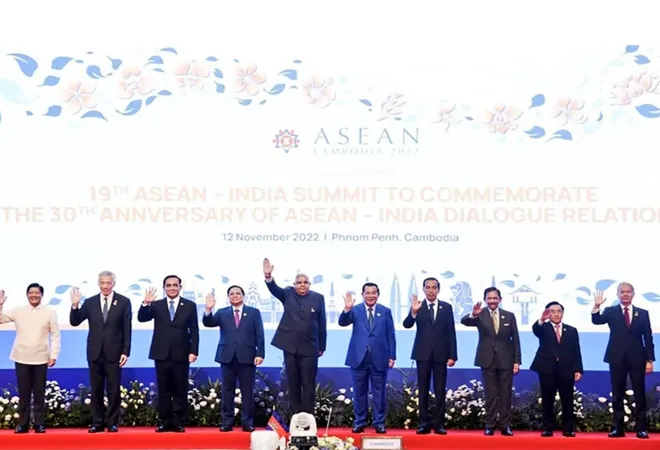-
CENTRES
Progammes & Centres
Location
In the face of geopolitical turmoil and a Chinese exit, India must negotiate its Indo-Pacific trade ties with caution

India-ASEAN partnership has certainly grown and today encompasses a wide set of issues ranging “"from connectivity to climate change, security to space, education to ecology and technology to trade.” There is a greater appreciation of India’s growing role in the wider Indo-Pacific among the ASEAN members and there is a new momentum in India’s outreach to the a geography critical to ensuring the ever so elusive balance in the emerging maritime confluence between the Indian and Pacific oceans. But the regional geopolitics and geoeconomics is undergoing a fundamental transformation at a pace that most actors are finding difficult to adapt quickly. The major power contestation of today is putting pressure on the ASEAN in ways it has not experienced since its very inception. For long, the assumption of China as primary economic partner and the US as the primary security guarantor has been at the heart of the ASEAN balance. Today, that balance is falling apart and the Russia-Ukraine war has further aggravated this tension. This sharpening of major power rivalry is threatening the underlying stability on which rested the regional growth and prosperity over the last several decades. The geopolitical tensions are also producing geoeconomic consequences where issues of trade and technology cooperation as well as supply chain resilience are being examined through a lens that was considered outdated till a few years back. And this is happening at a time when ASEAN remains a divided organisation internally on how to manage these challenges. The grouping remains fractured in its response to the Russian invasion of Ukraine, on managing the US-China contestation, and closer to home on dealing with the military junta in Myanmar and China’s aggression in the South China Sea. ASEAN will lose its relevance if it continues to be a divided house, unable to forge consensus on critical regional and global issues.The India-ASEAN joint statement while they acknowledging the deep civilisational linkages, maritime connectivity, and cross-cultural exchanges between the two geographies, further tried to galvanise this partnership by focusing on enhancing cooperation in the digital economy, smart agriculture, city-to-city partnerships.
And this matters because all major powers, including India, have ASEAN centrality at the core of their Indo-Pacific vision. ASEAN centrality will have no meaning with a fractured region unable to come to terms with the changing realities around its periphery. With a fragmented ASEAN, Indo-Pacific will continue to exude the instability and tensions that the world is trying to come to grips with at the moment. This is already evident in the way external powers are projecting their interests in the region. In order to isolate and put pressure on the Myanmarese junta, Washington has placed sanctions on the on the regime as well reached out to the opposition National Unity Government. On the other hand, Russia and China have been trying to do the opposite and even supplying weapons to the junta. In the midst of this, ASEAN’s response has been confusing and muddled. The initiative it seems is with outsiders rather than with the region and that’s not a great message about ASEAN centrality. And then there is the big question about China’s massive economic footprint in the region that gives Beijing a distinct advantage. Other powers have not been able to come up with a viable strategy. Even in the face of South China Sea onslaught, ASEAN members have not been able to push back given China’s role as the primary trading partner of the region with bilateral trade of around $880 billion. But with the US-China confrontation looming, the balancing is likely to become rather difficult. After the setback of Covid-19 pandemic, China is now seeking to revive the Belt and Road Initiative (BRI) and last week announced a number of new infrastructures projects in Southeast Asia. Under pressure with global supply chains being restructured, Beijing has also announced negotiations on ASEAN-China Free Trade Area “Version 3.0.”The major power contestation of today is putting pressure on the ASEAN in ways it has not experienced since its very inception.
India, therefore, will have to up its game significantly in order to remain relevant in a part of the world that is viewed as critical to the future stability and prosperity of the Indo-Pacific. Trade and connectivity will be critical in order to enhance its profile in the ASEAN region. But there should also be a concerted attempt by New Delhi to develop strong bilateral partnerships with like-minded partners within ASEAN. This is the age of minilaterals and India should not be shy of exploring them even In Southeast Asia as ASEAN will continue to struggle with its internal cohesion for the foreseeable future.China is now seeking to revive the Belt and Road Initiative (BRI) and last week announced a number of new infrastructures projects in Southeast Asia.
The views expressed above belong to the author(s). ORF research and analyses now available on Telegram! Click here to access our curated content — blogs, longforms and interviews.

Professor Harsh V. Pant is Vice President – Studies and Foreign Policy at Observer Research Foundation, New Delhi. He is a Professor of International Relations ...
Read More +